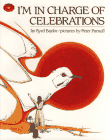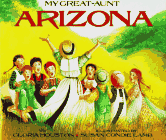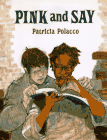Looking Critically at Picture Books

With increasing numbers of picture books aimed at older and more sophisticated readers comes the challenge to teachers and librarians to make those encounters more meaningful and enjoyable. This isn't always easy since most of us, when we learn to read fluently, concentrate on the text for meaning thus short-changing the illustrations which are at least as important as the text. Here are a few of the techniques I've used with success.
Use a technique suggested by Johnson and Lewis in Bringing it All Together (Heinemann, 1990 ISBN 0435085026). Seat the class in two long rows facing each other knee to knee. Tell them they must not turn around in their seats or look back over their shoulders. Also inform them that they must tell the person sitting directly in front of them what they see. Choose a picture book where the illustrations carry most of the plot such as David Macaulay's Rome Antics (Houghton, 1997 ISBN 0395822793. Order Info.) or Tuesday by David Wiesner (Clarion, 1997 ISBN 0395870828. Order Info. Review, Activies and Links.). Stand so that half the class is facing you. Show them the cover of the book. Keep it in front of them for only a short period of time before you walk to the other side of the group and show the part of the class now facing you the first page. Continue going back and forth, until each person has seen every other page of the book and has heard about the pages in between. Then have each pair of students go off by themselves to sketch a storyboard of the story. Post all the storyboards and compare them.
Instead of doing the storyboards in the activity above, have each pair of students draw a picture together on large sheets of newsprint of the part they liked best in the book and place a caption under it. On a large wall space, place all the pictures in the correct sequence. When there are duplicate scenes, place them vertically. Decide together what events in the story are not covered by anyone's picture and write sentences to cover that action.

Pair off the readers and give each pair a picture book you think they'd find interesting. Have one child concentrate on the illustrations while the other concentrates on the text as they go through the books slowly and carefully. When the book is finished, they close it and reconstruct the story together orally. Then, they switch roles with the same book before presenting the class with their reactions to it.
Form groups of three. Present each group with an appropriate picture book. They can read it aloud or silently but they carefully examine each page. Then, each member of the group must say something about it. Only when all three have commented can they go on to the next page. The comments tend to get better and better as they go on.
Suggest that each child find the picture book they loved most or remember best from when they were little. Then each should find a picture book they've discovered more recently that they really like. Comparing the two books can be done orally or in writing. Some of the things they might look for: the design of the books, use of color, simplicity of plot, mood, and role of the illustrations.

Students can scan the Internet to find websites or biographies of various authors and illustrators of children's picture books (including ours, see below). Then carefully examine the author's books to see how their personal lives have influenced their work.
Students choose an author or illustrator of picture books whose work they admire. They construct an exhibit of the artist and his or her work. Slightly apart from that exhibit they can place prints of fine art that bears some relationship to the author/illustrator's work.
After examining as many books as possible by a single picture book creator, children make lists of words that describe his or her work in general.
Have students prepare slides or multimedia presentations of a picture book artist's work.
 Students try to decide what medium the illustrator worked in. (That's not always easy.) They then use the same medium or something close to it to create other pictures. It's important that they not try to copy an illustration. That usually leads to frustration. Generally, my rule when doing artwork based on picture books is this: Vary one or more of the following: subject, media, mood, technique, or color.
Students try to decide what medium the illustrator worked in. (That's not always easy.) They then use the same medium or something close to it to create other pictures. It's important that they not try to copy an illustration. That usually leads to frustration. Generally, my rule when doing artwork based on picture books is this: Vary one or more of the following: subject, media, mood, technique, or color.
Some Picture Books That Work Well With the Activities Above:
- Baylor, Byrd. I'm in Charge of Celebrations Illustrated by Peter Parnall. (Simon & Schuster, 1986 ISBN 0684185792. Order Info.) Review.
- Bunting, Eve. The Wall Illustrated by Ronald Himler. (Clarion, 1990 ISBN 0395515882. Order Info.)
- Gerstein, Mordicai. The Wild Boy (Farrar Straus, 1998 ISBN 0374384312. Order Info.)
- Hendershot, Judith. In Coal Country Illustrated by Thomas Allen (Knopf, 1987 ISBN 0394981901. Order Info.)
- Houston, Gloria. My Great Aunt Arizona Illustrated by Susan Condie Lamb (HarperCollins, 1991 ISBN 0060226064. Order Info.) Review.
- Khan, Rukhsana. The Roses in My Carpets Illustrated by Ronald Himler (Holiday, 1998 ISBN 0823413993. Order Info.)
- Laminack, Lester. The Sunsets of Miss Olivia Wiggins Illustrated by Constance Bergum (Peachtree, 1998 ISBN 1562451398. Order Info.)
- Lasky, Kathryn. Marven of the Great North Woods Illustrated by Kevin Hawkes (Harcourt, 1997 ISBN 0152001042. Order Info.)
- Lewin, Ted. The Storytellers (Lothrop, 1998 ISBN 0688151787. Order Info.)
- Lyon, George Ella. Cecil's Story Illustrated by Peter Catalanotto (Orchard, 1991 ISBN 053107063. Order Info.) Review.
- Polacco, Patricia. Pink & Say (Philomel, 1994 ISBN 0399226710. Order Info.) Review.
- Say, Allen. Tree of Cranes (Houghton, 1991 ISBN 039552024X. Order Info.) Review.
- Van Allsburg, Chris. The Widow's Broom (Houghton, 1992 ISBN 0395640512. Order Info.)
- Weitzman, Jacqueline Preiss. You Can't Take a Balloon into the Metropolitan Museum Illustrated by Robin Preiss Glasser (Dial, 1998 ISBN 0803773014. Order Info.)

Related Areas of Carol Hurst's Children's Literature Site
- Author Studies of Picture Book Authors:
- Professional Books:
- Picture Book Guides by Carol Hurst et. al.
- Curriculum Connections: Picture Books in Grades 3 and Up by Carol Hurst. With a sample chapter.
- Picturing Math: Using Picture Books in the Math Curriculum by Carol Hurst and Rebecca Otis. With sample chapters.
- Subjects with Books, Activities and Links:
Related Areas on Other Web Sites
- University of Waikato's List of Sophisticated Picture Books:
http://www.waikato.ac.nz/library/resources/edu/booklst_sophis.shtml
Advertisement:
Advertisement:
Advertisement:

